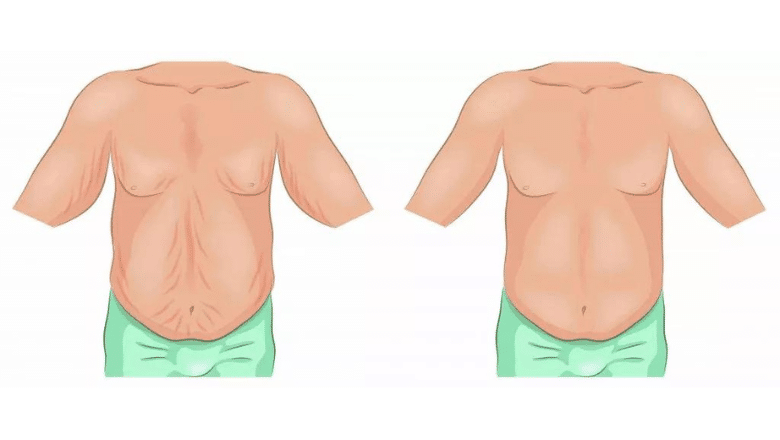Loose skin operation, medically termed post-bariatric body contouring surgery, has emerged as a transformative solution for individuals who have experienced significant weight loss. Clinical studies have documented that excess skin removal not only enhances physical appearance but also substantially improves quality of life metrics. According to research published in the Journal of Plastic and Reconstructive Surgery, 85% of patients report increased mobility and reduced skin infections following these procedures. The dramatic before and after results often showcase remarkable transformations—patients transition from dealing with uncomfortable skin folds that cause chafing, hygiene issues, and limited clothing options to enjoying a body contour that more accurately reflects their weight loss achievement.
Table of Contents
The psychological impact of loose skin operations proves equally significant as the physical benefits. Research from the American Society of Plastic Surgeons demonstrates that patients experience measurable improvements in body image perception and self-confidence following successful procedures. Before surgery, many patients describe feeling trapped in a body that doesn’t represent their health journey, despite having lost substantial weight. After recovery, these same individuals report feeling complete in their transformation process. The documented reduction in depression and anxiety scores following these procedures underscores the comprehensive health benefits beyond the visible physical changes, establishing loose skin operations as both a reconstructive and psychologically therapeutic intervention.
Cost Analysis of Loose Skin Removal Procedures
The financial investment required for excess skin removal procedures varies significantly based on several factors including procedure type, geographical location, and individual patient needs. Understanding these cost components helps patients prepare adequately for this significant medical expense.
Loose skin removal cost typically encompasses multiple financial elements that contribute to the total expense. Below are the primary cost factors patients should consider:
- Surgical Fees: The surgeon’s expertise and reputation directly impact costs, with more experienced surgeons typically charging premium rates
- Hospital or Facility Fees: Operating room costs and overnight stays significantly affect the total price
- Anesthesia Costs: Usually charged separately based on procedure duration and complexity
- Pre-operative Tests: Blood work, medical imaging, and consultations necessary before surgery
- Post-operative Garments: Compression garments essential for proper healing and results
- Prescription Medications: Pain management and infection prevention medications
- Follow-up Appointments: Multiple post-operative visits to monitor healing progress
The cost of loose skin removal surgery varies substantially by procedure type and body area. Different body regions require different surgical approaches, resulting in varying price points.
| Procedure Type | UK Average Cost (£) | US Average Cost ($) | Australia Average Cost (AUD) |
|---|---|---|---|
| Abdominoplasty | £5,000 – £8,000 | $6,000 – $12,000 | $8,000 – $15,000 |
| Arm Lift | £4,000 – £6,000 | $4,500 – $8,000 | $6,000 – $10,000 |
| Thigh Lift | £5,500 – £7,500 | $5,000 – $10,000 | $7,000 – $12,000 |
| Full Body Lift | £12,000 – £20,000 | $15,000 – $30,000 | $20,000 – $35,000 |
| Breast Lift | £4,500 – £7,000 | $5,000 – $9,000 | $7,000 – $12,000 |
This table reflects average price ranges based on current market data, though individual clinics may charge outside these ranges depending on their specific factors.
Regional variations in excess skin removal cost UK compared to other countries are significant. The National Health Service (NHS) occasionally covers these procedures when medical necessity is demonstrated, such as mobility issues or recurring infections. However, most patients pursue private treatment due to strict NHS criteria.
Insurance coverage represents another critical financial consideration. Most insurance providers classify excess skin removal as cosmetic rather than medically necessary, resulting in limited coverage options. Patients should thoroughly investigate potential coverage by:
- Documenting medical complications caused by excess skin
- Obtaining detailed physician statements confirming medical necessity
- Researching insurance policies that might cover reconstructive procedures
- Considering specialized bariatric surgery insurance packages that include post-weight loss surgeries
Financing options have become increasingly accessible for patients seeking loose skin removal procedures. Many surgical facilities offer payment plans, medical loans, or partnerships with healthcare financing companies. These arrangements typically feature:
- Extended payment periods of 12-60 months
- Competitive interest rates compared to standard credit cards
- Simplified application processes for medical procedures
- No early repayment penalties
Hidden costs often surprise patients pursuing loose skin removal surgery. These may include travel expenses for specialized care, accommodation during recovery, household assistance during healing, and potential income loss during extended recovery periods. This becomes particularly evident when patients compare their expectations with Weight Loss Surgery Results, as the desire for a smooth, toned appearance after the loose skin operation before and after can be significant. Thorough research and consultation with a qualified surgeon can help set realistic expectations and prepare for these hidden costs.
Choosing a Qualified Skin Removal Surgeon
Finding the best loose skin removal surgeon requires careful research and consideration of several critical factors. The expertise and qualifications of your chosen surgeon directly impact the success of your procedure and overall satisfaction with the results.
Key Qualifications to Look For
When evaluating potential surgeons for loose skin removal procedures, focus on these essential qualifications:
- Board Certification in plastic surgery or related surgical specialty, preferably from the American Board of Plastic Surgery or equivalent international certification bodies
- Specialized Training in body contouring procedures, particularly post-weight loss surgeries
- Years of Experience performing various loose skin removal procedures including abdominoplasty, brachioplasty, and thighplasty
- Before and After Portfolio demonstrating consistent results with patients who have similar body types and concerns
- Hospital Affiliations with reputable medical institutions that maintain high standards of care
- Professional Memberships in organizations like the American Society of Plastic Surgeons or International Society of Aesthetic Plastic Surgery
The best loose skin removal surgeon will possess extensive knowledge of human anatomy and tissue manipulation techniques. Their expertise should encompass various body contouring approaches to address different areas affected by skin laxity.
Assessment Process
Follow these steps to thoroughly evaluate potential surgeons:
- Conduct Background Research by reviewing the surgeon’s educational background, training, and professional history through their website and medical board databases
- Schedule Consultations with at least three qualified surgeons to compare their approaches and recommendations
- Ask Detailed Questions about their experience with cases similar to yours, including how many procedures they perform annually
- Evaluate Communication Style to ensure the surgeon listens to your concerns and explains procedures in understandable terms
- Request References from former patients who underwent similar procedures
- Review Facility Accreditation to confirm that surgeries are performed in properly certified surgical centers
Successful loose skin removal depends on the surgeon’s ability to assess skin elasticity, muscle tone, and fat distribution accurately. The best practitioners employ advanced techniques like progressive tension sutures and strategic incision placement to maximize aesthetic outcomes.
Red Flags to Watch For
Be wary of practitioners who demonstrate these concerning signs:
- Overpromising Results or making guarantees that seem unrealistic
- Pressure Tactics to commit to surgery without adequate consideration
- Lack of Specialization in body contouring procedures
- Inability to Answer specific questions about their approach to your case
- Limited Before/After Photos of patients with similar conditions
- Poor Online Reviews especially those mentioning communication issues or complications
The best loose skin removal surgeons maintain memberships in professional organizations that require ongoing education and adherence to ethical standards. They regularly participate in advanced training to learn new techniques and safety protocols.
A qualified surgeon will also collaborate with an experienced medical team, including anesthesiologists and nursing staff specialized in surgical care. This comprehensive approach ensures optimal patient safety throughout the entire procedure and recovery process.
Loose Skin Surgery Results and Recovery Timeline
The transformation journey after significant weight loss often concludes with loose skin removal surgery, offering patients renewed confidence and comfort. Many individuals experience dramatic physical changes following these procedures, with loose skin removal before and after weight loss photos showcasing remarkable transformations. Patients typically observe immediate changes upon bandage removal, though final results develop gradually as swelling subsides and tissues settle.
The body’s appearance undergoes significant positive changes after loose skin surgery. Initially, patients notice tighter contours where excess skin once hung, particularly in common problem areas like the abdomen, arms, thighs, and chest. Pictures of loose skin after weight loss compared to post-surgical results demonstrate the dramatic improvement in body shape and proportion. Most patients report that their bodies finally match their weight loss achievements, with clothing fitting better and physical activities becoming more comfortable without excess skin creating friction or discomfort.
Pain management remains a crucial component of recovery, varying throughout different healing phases:
- Immediate post-operative period (Days 1-3): Prescription pain medications, carefully monitored by medical staff, help manage the initial discomfort which is typically most intense during this phase
- Early recovery phase (Days 4-14): Transition to over-the-counter pain relievers as prescribed pain medications are gradually reduced, supplemented with cold therapy for localized swelling
- Mid-recovery phase (Weeks 3-6): Gentle stretching exercises as recommended by surgeons, complemented by proper hydration and nutrition to support healing tissues
- Long-term recovery (Months 2-6): Mind-body techniques including meditation and deep breathing to address occasional discomfort during scar maturation
Many patients wonder how painful is loose skin surgery recovery. While individual experiences vary, most describe the sensation as moderate discomfort rather than severe pain. The tightness and pulling sensations tend to be more persistent than sharp pain, particularly when moving or changing positions. Surgical techniques have advanced significantly, with nerve-sparing approaches and improved pain management protocols making recovery more tolerable than in previous decades.
The recovery timeline unfolds in distinct stages, each marked by specific healing milestones:
- Initial Recovery (Week 1): Significant swelling, bruising, and moderate pain requiring consistent medication management; limited mobility with assistance needed for basic activities
- Early Healing (Weeks 2-3): Drainage tubes typically removed; transition to light movement with reduced pain medication; initial loose skin operation before and after differences become visible as major swelling subsides
- Progressive Improvement (Weeks 4-6): Return to light daily activities; continued improvement in comfort and mobility; compression garments still necessary for optimal results
- Advanced Recovery (Weeks 7-12): Resumption of most normal activities including light exercise; scar tissue begins maturing; final body contours starting to emerge
- Final Results (Months 6-12): Complete resolution of swelling; scars begin fading from red to white; true loose skin surgery results become fully apparent
Physical therapy often plays a vital role in optimal recovery, helping patients regain full range of motion and strength in affected areas. Therapists work with patients to develop customized exercise programs that respect healing tissues while preventing muscle atrophy or joint stiffness. These programs typically progress from gentle stretching to more dynamic movements as healing advances.
Patients consistently report that despite the recovery challenges, the transformation revealed in loose skin removal before and after weight loss documentation makes the journey worthwhile. The physical relief from no longer carrying excess skin combines with psychological benefits, creating a comprehensive improvement in quality of life that extends far beyond cosmetic enhancement.



